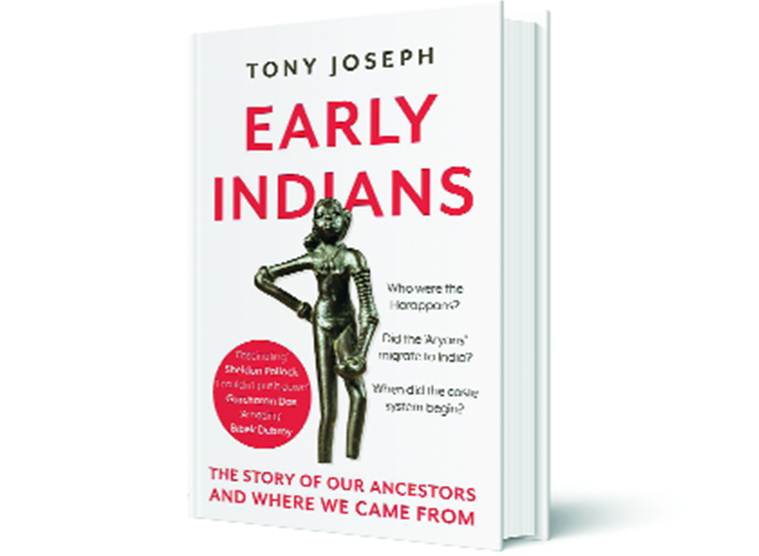Written by Pratik Kanjilal |Published: February 9, 2019 2:10:12 am
A Question of Identity
Through the everchanging frame of prehistory, a look at the evolutionary story of we, the people.

Book: Early Indians
Author: Tony Joseph
Publication: Juggernaut
Pages: 262
Price: 699
Author: Tony Joseph
Publication: Juggernaut
Pages: 262
Price: 699
First, the mandatory disclosure: back in the Nineties, Tony Joseph hired me to start a new section in a business publication. He was a brave man. Two decades after, he has proved his bravery again, venturing into a politically fraught subject at the confluence of population genetics, archaeology and anthropology. After a long career in the business press, where the intellectual challenges are fairly meagre — talking up the dreary cola wars that break out every summer, editing fiction out of PR spin, spinning out vapourware headlines about motivation, understanding the clever dodge of the Special Purpose Vehicle — he has chosen to focus on the most challenging questions ever: who are we, and where did we come from? And what does ‘we’ mean anyway, in the frame of prehistory, which is continents wide and tens of thousands of years deep?
Joseph has approached these questions in the manner of the reporter that he was decades ago, visiting archaeological digs, interviewing the people investigating the remote past and trawling through the literature, both popular and academic. The last is especially challenging, at a time when academics are rapidly deploying new scientific tools whose findings are overturning perceptions long held dear. For instance, the Denisovan culture was discovered in 2010 and still awaits taxonomic classification.
The findings in the Denisova cave in the Altai mountains consist of only a couple of teeth and the finger bone of a woman. We know precisely nothing of Denisovan material culture but in the last eight years, on the basis of their DNA alone, a surprisingly detailed picture has emerged of how their genome has travelled, and it is known with some certainty that they met with sapiens twice, found them agreeable, and mated. As Joseph points out, Melanesians and aboriginal Australians have significant Denisovan genetic material. Equally, the Tibetans’ ability to flourish in high altitudes may owe to a Denisovan contribution, and there may have been a minor southward migration into eastern India and down the Coromandel coast. In which case, both Joseph and I may have Denisovan DNA. Not much, less than 1 per cent, but a little variety is always nice.
Almost 40 years ago, and a decade before identity politics raised its ugly head in India, Salman Rushdie’s Midnight’s Children made a persuasive case for a “chutnified” cultural identity, indicating the puerile futility of our obsession with ideas of purity and pollution. Current research in palaeobiology, which Joseph recaps in detail, establishes the scientific basis of chutnification, created by wave on wave of migrations and minglings in prehistory. For the details of arcana like haplogroup L3, the reader would be best served by Joseph’s short and lucid explanation of human genetics. But broadly speaking, we can confidently say that all of us are descended from a primordial Eve (Adam is not so readily identified for purely genetic reasons), whose descendants came out of Africa to populate the world, first ranging eastwards through the Levant and Arabia into the Asian mainland, and then northwards into Europe.
The unity of the human race is bad news for politics that thrives on difference, and in the manner of a good editor, Joseph is alive to the reality that academic conclusions are conditioned by political contexts. This is not necessarily bias, “but the genuine belief that the truth might cause harmful side effects.” Migration from Central Asia into India is real (though not in the manner that Bal Gangadhar Tilak articulated it, with the meagre scientific evidence available in his time), and influenced the group known as Ancestral North Indian, but there could be a tendency to play it down, given the current salience of identity politics. Just as, in the last century, in the shadow of Partition, it was thought prudent to play down the atrocities of certain Muslim rulers, and to talk up Akbar’s liberal policies and Din-i-Ilahi, an artificial faith that did not live much longer than its founder. The long tail of that tweak is now lashing out viciously against academically sound left-wing historians. Logically, the truth should reduces contention, but it causes anxiety by destroying fantasies about the past and dreams of the future
Traditionally, history has been told through watershed moments like the arrival of various incursions — from horse-borne nomads from the steppe to sea-borne Europeans — but Joseph suggests that history consists of lengthy processes rather than quick, cataclysmic events. His story, which begins in the prehistoric art gallery of Bhimbetka and ends with the eclipse of the Harappan civilisation in the face of climate change, presents the Indian population as a ‘pizza’. The base is formed of migrants out of Africa about 65,000 years ago, the sauce is the Harappan culture (which itself included migrants), the mozzarella consists of migrants under the umbrella term ‘Aryan’, and the toppings are later arrivals — Austroasiatics and Tibeto-Burmans, followed by sprinklings of Huns, Sakas, Baghdadi Jews, Armenians, Mughals and Europeans.
The errors in this long story are trivial, such as mitochondrial DNA being identified as the ‘powerhouse of the cell’ (it’s the mitochondrion, actually, which synthesises adenosine triphosphate), and Joseph has told an extremely complex tale very lucidly. It’s quite remarkable, in a field where new information seems to appear almost every month, confirming or questioning old certainties. India could have faced a drought of accessible writing on academic questions after the generation represented by Jayant Narlikar, Irfan Habib and Romila Thapar, but new arrivals like the South Asian natural history of Pranay Lal (Indica, Allen Lane, 2016), and Joseph’s exploration of the humanscape, offer considerable promise. Read Early Indians soon, before prehistory changes again.






















No hay comentarios:
Publicar un comentario